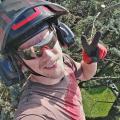
Pruning plane trees while they’re in leaf can cause serious health problems for the public and workers – as this tree surgeon of nearly 20 years can attest.
I was once part of a tree team that was sent out to pollard a row of 15 plane trees. It was springtime and they were in leaf.
The road was not closed, but we occupied it with three trucks and two woodchippers. We were three climbers including myself, with a large ground crew to process and chip the limbs as they came down.
I remember being fine in the tree, but then when I joined the ground crew to finish the job, I had a bad reaction to the fine leaf hairs that had been ejected into the atmosphere. The leaves had been passing through the woodchipper for several hours and our work environment had become encased in a cloud of plane tree particulates.

I had worked on them before and not suffered more than a mild cough, but this time my reaction was quite severe. I suffered intense coughing and retching. My eyes were streaming and I was, at times, bent double.
Recently, I was asked to go to London and prune planes in mid April. I said no to three days’ subcontractor climbing in London because I won’t willingly put myself in that position again. Not only would I be putting myself at risk, but from a business standpoint
I am keen to follow through on my commitments. Since I couldn’t be certain to finish what I’d be paid to do, I couldn’t commit.
As tree workers, it’s prudent to be aware of the negative respiratory health impacts of pruning plane trees while they are in leaf. This is because in this state plane trees release a significant amount of fine dust and volatile organic compounds (VOCs) that can be hazardous to respiratory systems.
Among the major sources of these harmful particles are the trichomes, tiny hairs on the green leaves released into the air by cutting and processing the leaves and branches of the tree. Woodchippers spread the trichomes into the air and surrounding environment, creating an unsafe working area.
READ MORE: BSW's Southampton sawmill facing closure with job losses likely
This dust, when inevitably inhaled, causes a health risk to tree workers and to the public.
It can result in respiratory irritation, including severe coughing, wheezing and a shortness of breath, such as I experienced.
These trichomes are possibly a result of an evolutionary deterrent mechanism against animals that might have damaged the tree for various reasons. They can cause eye, nose, and throat irritation, headaches, and dizziness when inhaled. Additionally, these compounds can have longer lasting effects on the respiratory systems of those who inhale them.
From a risk management view, one solution is for tree workers to use a particulate mask, but for a climber this is inconvenient and uncomfortable. To mitigate against this, in some cases a mobile elevated working platform (MEWP) could be used. However, regardless of these solutions, it still goes against industry standards to prune a tree outside of its own period of dormancy.
To ensure the overall health of the tree, it is recommended they are only pruned while they are dormant, as the tree is in a state of rest. Consequently, pruning causes less of a stress response, the wounds heal more efficiently, and more energy is available for new growth when the tree awakens in the spring. Furthermore, while dormant there are no leaves on the trees from which to release the problematic trichomes into the air during pruning.

While it is known among those who’ve experienced the negative health impacts of working with plane trees, there is little in place to prevent a firm or a tree worker from being asked to undertake these works while they are in leaf.
This is an oversight, seeing as the negative respiratory health impacts of pruning plane trees while they are in leaf are significant and can be hazardous to the respiratory system of anyone in the nearby vicinity.
To protect tree workers and the public, and to ensure the overall health of the tree, the employees, employers, subcontractors, local authorities and governing bodies should all agree to only prune plane trees while they are dormant.



Comments: Our rules
We want our comments to be a lively and valuable part of our community - a place where readers can debate and engage with the most important local issues. The ability to comment on our stories is a privilege, not a right, however, and that privilege may be withdrawn if it is abused or misused.
Please report any comments that break our rules.
Read the rules here